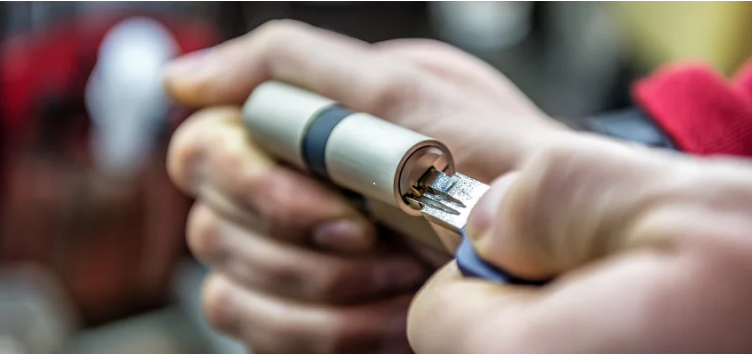Locks are intricate devices with a complex mechanism that serves to secure doors, safes, and various other items. A key component of any lock is the lock cylinder, which houses several internal elements such as springs, pins, and pawls.
The pawls are responsible for engaging and disengaging the lock when the correct key is used. When properly aligned, the pawls straddle key components of the lock system, ensuring smooth operation.
In this article, we focus on a critical aspect: why the pawls on the lock cylinders should straddle item 7. This precise alignment plays a pivotal role in ensuring the integrity and functionality of the lock. A misaligned pawl could cause security issues or lead to the failure of the locking mechanism entirely.
What Are Pawls and Their Role in Lock Cylinders?
Before delving into the specifics of straddling item 7, it’s essential to understand what pawls are. In lock cylinders, pawls are small, pivoted levers that engage with the locking mechanism to allow or prevent rotation. They help maintain security by interacting with key parts of the lock, ensuring that only the correct key or mechanism can rotate the cylinder and unlock the device.
When we say that “the pawls on the lock cylinders should straddle item 7,” we’re referring to the correct positioning of these levers over a particular part of the locking mechanism.
Why Straddle Item 7?
Item 7 refers to a specific part in a lock cylinder mechanism that ensures proper alignment and smooth operation. When pawls are correctly straddling this item, they maintain proper balance within the lock cylinder. This alignment is essential because:
Smooth Functionality: If the pawls don’t straddle item 7, they may cause jamming or resistance when turning the key. This improper alignment could lead to operational failures and cause the lock to malfunction over time.
Enhanced Security: Locks are designed with security in mind. Misaligned pawls create vulnerabilities that can be exploited, weakening the overall security of the system. Correctly straddling item 7 ensures the lock remains difficult to tamper with.
Durability: Over time, a lock with misaligned pawls will wear down faster. The friction and pressure caused by improper alignment can cause internal components to deteriorate, shortening the lifespan of the lock. Proper alignment with item 7 helps mitigate wear and tear.
Lock Compatibility: Many lock designs rely on exact configurations of internal components to work in harmony. A lock where the pawls straddle item 7 is more likely to be compatible with multiple types of keys, enhancing its versatility.
Signs of Misaligned Pawls in Lock Cylinders
Detecting an issue with the alignment of pawls is essential for ensuring the longevity and effectiveness of your lock. Some common signs that the pawls are not correctly straddling item 7 include:

Difficulty Turning the Key: If the key gets stuck or you experience resistance while turning it, this could indicate that the pawls are not properly aligned.
Lock Jamming: A lock that occasionally jams or fails to open might have pawls that are off-center or not straddling item 7 correctly.
Inconsistent Locking: If the lock sometimes works but other times doesn’t engage properly, pawl misalignment may be to blame.
Frequent Key Wear: When pawls are not aligned, the extra friction caused can wear down the key quickly, indicating a problem with the internal mechanics of the lock.
Fixing the Alignment of Pawls
Aligning the pawls in a lock cylinder should be left to professionals, as improper handling could cause further damage to the lock. If you suspect that the pawls in your lock are not straddling item 7 correctly, it’s best to consult a locksmith.
That said, here are some general steps professionals might follow:
Disassemble the Lock: The locksmith will remove the lock from the door or object to inspect its internal mechanics.
Realign Pawls: Once the cylinder is exposed, the pawls can be adjusted to ensure they are correctly straddling item 7. This process involves precision to avoid damaging other internal parts of the lock.
Reassemble the Lock: After realigning the pawls, the lock is reassembled, ensuring that it functions correctly and smoothly.
Preventive Measures to Ensure Proper Pawl Alignment
While pawl misalignment can be fixed, prevention is always better than cure. By following a few simple guidelines, you can maintain the functionality of your locks:
Regular Maintenance: Like any mechanical system, locks benefit from regular maintenance. Lubricate the lock periodically to ensure smooth movement and prevent friction from causing pawl misalignment.
Avoid Using Force: If a key doesn’t turn smoothly, avoid using excessive force. Forcing the key can damage the internal components and lead to misalignment of the pawls.
Use the Correct Key: Always use the correct key for the lock. Using an incorrect or poorly cut key can cause internal stress on the lock’s components, including the pawls.
Professional Installation: Ensure locks are installed by professionals. Poor installation is a common cause of misalignment in lock cylinders.
Conclusion
Ensuring that the pawls on the lock cylinders should straddle item 7 is a key aspect of maintaining a secure and functional lock system. Proper alignment prevents unnecessary wear, maintains the lock’s security, and ensures smooth operation over time. While alignment issues may arise due to wear or improper handling, addressing them early on with professional help can save you from larger security concerns in the future.

